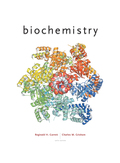
Concept explainers
Answers to all problems are at the end of this book. Detailed solutions are available in the Student Solutions Manual, Study Guide, and Problems Book.
Understanding the Occurrence of Natural Phospholipids In problem 1 (b) ill Chapter 8, you weft asked to draw all the possible phosphate-dylserme isomers that form be formed from palmitic and linolenie acids. Which of the PS isomers aft not likely ll> be found in biological membranes?
Interpretation:
The PS isomer which is not likely to be found in biological membranes should be determined.
Concept Introduction:
There are two wide kinds of isomers: stereoisomers and constitutional.
Constitutional isomers vary in connectivity and bonding, whereas stereoisomers vary in 3-D orientation.
Answer to Problem 1P
Two structures having linolenic acid is connected to the initial carbon and palmitic acid is attached to the second carbon.
Explanation of Solution
Lipid is in proximity within biological membranes. Formation of double bond results in the bend in the chain which creates space among lipids.
Phosphatidyl serine molecules contain the big group on glycerol’s third carbon. Due to this group, the 2nd and 3rd carbons of glycerol contain more space as compared to the first carbon.
The fatty acid that attaches to the first carbon is usually a saturated fatty acid. An unsaturated fatty acid attaches to the second carbon.
Phosphatidylserines contain the phosphate bond in the serine residue on the 3rd carbon of glycerol.
Linoleic acid contains two common forms, thus, there are four kinds of different phosphatidylserines created with linoleic and palmitic acid.
The structure is shown as follows:

Want to see more full solutions like this?
Chapter 9 Solutions
EBK BIOCHEMISTRY
- You were given a mixture of two proteins with different isoelectric points and molecular weights:• Protein X: pI 4.2, MW 42,000• Protein Y: pI 9.8, MW 90,000Using a Tris-glycine discontinuous native gel (pH8.3) electrophoresis system with a running gel of 12%, only a single band was observed upon protein staining after electrophoresis. Explain the observed result and discuss possible factors affecting protein migration in this system.arrow_forwardThe standard cost of Product B manufactured by Oriole Company includes 3.5 units of direct materials at $5.40 per unit. During June, 27,300 units of direct materials are purchased at a cost of $5.15 per unit, and 27,300 units of direct materials are used to produce 7,600 units of Product B. (a) Compute the total materials variance and the price and quantity variances. Total materials variance Materials price variance Materials quantity variance $ (b) Compute the total materials variance and the price and quantity variances, assuming the purchase price is $6.35 and the quantity purchased and used is 26,300 units. Total materials variance Materials price variance Materials quantity variance $arrow_forwardThe pyruvate dehydrogenase complex catalyzes the oxidative decarboxylation of pyruvate to form acetyl CoA. E₁, E2, and E3 are abbreviations for the enzymes of the complex. Classify the enzyme names, prosthetic groups, and reactions as E1, E2, or E3. E₁ E2 Answer Bank E3 transfer of electrons to FAD and then to NAD+ transfer of acetyl group to coenzyme A formation of hydroxyethyl-TPP hydroxyethyl group transferred to lipoamide thiamine pyrophosphate (TPP) FAD lipoamide dihydrolipoyl transacetylase pyruvate dehydrogenase dihydrolipoyl dehydrogenasearrow_forward
- Patients with pyruvate dehydrogenase deficiency show high levels of lactic acid in the blood. However, in some cases, treatment with dichloroacetate (DCA), which inhibits the kinase associated with the pyruvate dehydrogenase complex, lowers lactic acid levels. How does DCA act to stimulate pyruvate dehydrogenase activity? DCA activates pyruvate dehydrogenase kinase. DCA increases phosphorylation levels of pyruvate dehydrogenase. DCA inhibits pyruvate dehydrogenase kinase. ODCA activates pyruvate dehydrogenase phosphatase. What does this suggest about pyruvate dehydrogenase activity in patients who respond to DCA? The pyruvate dehydrogenase complex is active only when phosphorylated by the kinase. The pyruvate dehydrogenase complex is active only in the presence of the kinase. The pyruvate dehydrogenase complex is completely inactive. The pyruvate dehydrogenase complex displays some residual activity.arrow_forwardThe reduced coenzymes generated by the citric acid cycle donate electrons in a series of reactions called the electron-transport chain. The energy from the electron-transport chain is used for oxidative phosphorylation. Which compounds donate electrons to the electron- transport chain? H₂O NADH பப NAD+ ATP ADP FADH₂ FAD Which compounds are the final products of the electron-transport chain and oxidative phosphorylation? H₂O NADH NAD+ ΠΑΤΡ Π ADP FADH₂ FAD Which compound is the final electron acceptor in the electron-transport chain? Оно NADH NAD+ ATP ADP FADH₂ FADarrow_forwardHexokinase in red blood cells has a Michaelis constant (KM) of approximately 50 μM. Because life is hard enough as it is, let's assume that hexokinase displays Michaelis-Menten kinetics. What concentration of blood glucose yields an initial velocity (V) equal to 90% of the maximal velocity (Vmax)? [glucose] = What does the calculated substrate concentration at 90% Vmax tell you if normal blood glucose levels range between approximately 3.6 and 6.1 mM? Hexokinase operates near Vmax only when glucose levels are low. Hexokinase normally operates far below Vmax. Hexokinase operates near Vmax only when glucose levels are high. Hexokinase normally operates near Vmax mMarrow_forward
- Classify each coenzyme or distinguishing characteristic based on whether it corresponds to catalytic or stoichiometric coenzymes. Catalytic coenzymes Answer Bank Stoichiometric coenzymes lipoic acid FAD used once coenzyme A regenerated thiamine pyrophosphate (TPP) NAD+arrow_forwardThe oxidation of malate by NAD+ to form oxaloacetate is a highly endergonic reaction under standard conditions. AG +29 kJ mol¹ (+7 kcal mol-¹) Malate + NAD+ oxaloacetate + NADH + H+ The reaction proceeds readily under physiological conditions. = Why does the reaction proceed readily as written under physiological conditions? The NADH produced during glycolysis drives the reaction in the direction of malate oxidation. The steady-state concentrations of the products are low compared with those of the substrates. The reaction is pushed forward by the energetically favorable oxidation of fumarate to malate. Endergonic reactions such as this occur spontaneously without the input of free energy. Assuming an [NAD+ ]/[NADH] ratio of 8, a temperature of 25°C, and a pH of 7, what is the lowest [malate]/[oxaloacetate] ratio at which oxaloacetate can be formed from malate? [malate] [oxaloacetate]arrow_forwardCalculate and compare the AG values for the oxidation of succinate by NAD+ and FAD. Use the data given in the table to find the E of the NAD+: NADH and fumarate:succinate couples, and assume that E for the enzyme-bound FAD: FADH2 redox couple is nearly +0.05 V. Oxidant Reductant " E' (V) NAD+ NADH + H+ 2 -0.32 Fumarate Succinate AG°' for the oxidation of succinate by NAD+: AG°' for the oxidation of succinate by FAD: 2 -0.03 Why is FAD rather than NAD+ the electron acceptor in the reaction catalyzed by succinate dehydrogenase? The electron-transport chain can regenerate FAD, but not NAD+. FAD is an oxidant, whereas NAD+ is a reductant. The oxidation of succinate requires two NAD+ molecules but only one FAD molecule. The oxidation of succinate by NAD+ is not thermodynamically feasible. kJ mol-1 kJ mol-1arrow_forward
- Use the cellular respiration interactive to help you complete the passage. 2,4-dinitrophenol (DNP) was a popular ingredient in diet pills in the 1930s before it was discovered that moderate doses of the compound cause exceptionally high body temperature and even death. Complete the passage detailing how DNP's mechanism of action explains why it causes both high body temperature and weight loss. 2,4-dinitrophenol (DNP) causes of returning to the mitochondrial matrix through to pass directly across the inner mitochondrial membrane instead proteins. Because of DNP's effect on the mitochondrion, less energy is captured in the form of energy is instead wasted as heat. and more protons electrons ATP NADH sugars cytochrome ATP synthase heatarrow_forwardTo answer this question, you may reference the Metabolic Map. Select the reactions of glycolysis in which ATP is produced. 1,3-Bisphosphoglycerate 3-phosphoglycerate Glyceraldehyde 3-phosphate 1,3-bisphosphoglycerate Fructose 6-phosphate fructose 1,6-bisphosphate Phosphoenolpyruvate pyruvate Glucose glucose 6-phosphate Suppose 17 glucose molecules enter glycolysis. Calculate the total number of inorganic phosphate (P) molecules required as well as the total number of pyruvate molecules produced. P required: pyruvate produced: molecules moleculesarrow_forwardSuppose a marathon runner depletes carbohydrate stores after a four-hour run. The runner's nutritionist suggests replenishing carbohydrate stores by eating carbohydrates. However, the runner is also concerned about weight loss and wants to know if fats can be directly converted into carbohydrates. How should the nutritionist respond to the runner? Yes, the glyoxylate cycle can be used to convert acetyl CoA into succinate, which can then be converted into carbohydrates. No, the two decarboxylation reactions of the citric acid cycle preclude the net conversion of acetyl CoA into carbohydrates. No, the citric acid cycle converts acetyl CoA into oxaloacetate, but there is no pathway to form glucose from oxaloacetate. Yes, pyruvate carboxylase can convert acetyl CoA into pyruvate, which can be used to form glucose through gluconeogenesis.arrow_forward
 BiochemistryBiochemistryISBN:9781305577206Author:Reginald H. Garrett, Charles M. GrishamPublisher:Cengage Learning
BiochemistryBiochemistryISBN:9781305577206Author:Reginald H. Garrett, Charles M. GrishamPublisher:Cengage Learning
